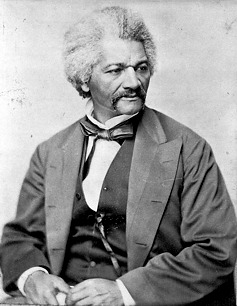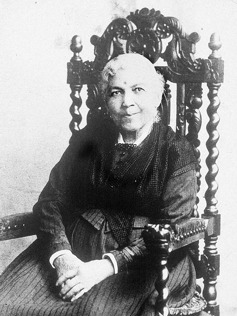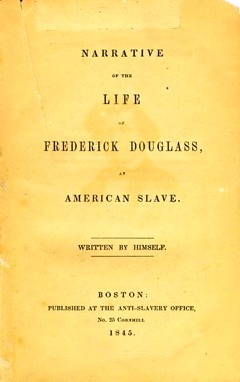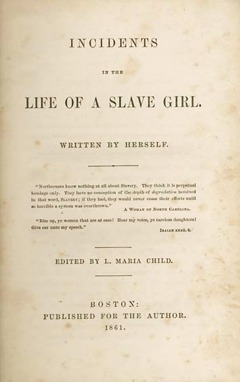


Frederick Douglass and Harriet Jacobs: American Slave Narrators
 Frederick Douglass |
|
 Harriet Jacobs |
|
Some of the differences in the readership and reception of Jacobs’s 1861 narrative and Douglass’s first, 1845 autobiography (he wrote two more, in 1855 and 1881, the latter expanded in 1892) reflect simply the differing literary and political circumstances that prevailed at the time of their construction and publication. When Douglass published his Narrative of the Life, the Abolitionist movement was beginning to gain political force, while the long-delayed publication of Jacobs’s Incidents in 1861 was overshadowed by the start of the Civil War. Douglass was a publicly acclaimed figure from almost the earliest days of his career as a speaker and then a writer. Harriet Jacobs, on the other hand, was never well-known. Incidents in the Life of a Slave Girl disappeared from notice soon after its publication, without a large sale, while Douglass’s first book went through nine editions in its first two years and eventually became the standard against which all other slave narratives—even his own later ones—are measured.
Douglass’s 1845 narrative grew out of the story of enslavement that he honed as a speaker for the Massachusetts Antislavery Society. “Discovered” and hired to lecture on the abolitionist circuit by William Lloyd Garrison in 1841, three years after he had made his escape from Baltimore, Douglass developed rhetorical devices common to sermons and orations and carried these over to his narrative, which abounds with examples of repetition, antithesis, and other classical persuasive strategies. His narrative was the culmination of his speech-making career, reflecting his mastery of a powerful preaching style along with the rhythms and imagery of biblical texts that were familiar to his audiences. Douglass also reflected the Emersonian idealism so prominent in the 1840s, as he cast himself in the role of struggling hero asserting his individual moral principles in order to bring conscience to bear against the nation’s greatest evil. In addition, his story could be read as a classic male “initiation” myth, a tale which traced a youth’s growth from innocence to experience and from boyhood into successful manhood; for Douglass, the testing and journey motifs of this genre were revised to highlight the slave’s will to transform himself from human chattel into a free American citizen.
Harriet Jacobs, on the other hand, began her narrative around 1853, after she had lived as a fugitive slave in the North for ten years. She began working privately on her narrative not long after Cornelia Grinnell Willis purchased her freedom and gave her secure employment as a domestic servant in New York City. Jacobs’s manuscript, finished around four years later but not published for four more, reflects in part the style, tone, and plot of what has been called the sentimental or domestic novel, popular fiction of the mid-nineteenth century, written by and for women, that stressed home, family, womanly modesty, and marriage. In adapting her life story to this genre, Jacobs drew on women writers who were contemporaries and even friends, including well-known writers Lydia Maria Child and Fanny Fern (her employer’s sister in law), but she was also influenced by the popularity of Harriet Beecher Stowe’s Uncle Tom’s Cabin, which appeared in 1851.
Stowe’s genius lay in her ability to harness the romantic melodrama of the sentimental novel to a carefully orchestrated rhetorical attack against slavery, and no abolitionist writer in her wake could steer clear of the impact of her performance. Jacobs, and also Frederick Douglass in his second autobiography of 1855, took advantage of Stowe’s successful production of a work of fiction that could still lay claim to the authority of truth. Incidents in the Life of a Slave Girl did not fictionalize or even sensationalize any of the facts of Jacobs’s experience, yet its author, using pseudonyms for all of her “characters,” did create what William Andrews has called a “novelistic” discourse,1 including large segments of dialogue among characters. Jacobs used the devices of sentimental fiction to target the same white, female, middle-class, northern audiences who had been spellbound by Uncle Tom’s Cabin, yet her narrative also shows that she was unwilling to follow, and often subverted, the genre’s promotion of “true womanhood,” a code of behavior demanding that women remain virtuous, meek, and submissive, no matter what the personal cost.
Gender considerations account not only for many of the differences in style and genre that we see in Douglass’s and Jacobs’s narratives, but also for the versions of slavery that they endured and the versions of authorship that they were able to shape for themselves in freedom. Douglass was a public speaker who could boldly self-fashion himself as hero of his own adventure. In his first narrative, he combined and equated the achievement of selfhood, manhood, freedom, and voice. The resulting lead character of his autobiography is a boy, and then a young man, who is robbed of family and community and who gains an identity not only through his escape from Baltimore to Massachusetts but through his ability to create himself through telling his story. Harriet Jacobs, on the other hand, was enmeshed in all the trappings of community, family, and domesticity. She was literally a “domestic” in her northern employment, as well as a slave mother with children to protect, and one from whom subservience was expected, whether slave or free. As Jacobs pointedly put it, "Slavery is bad for men, but it is far more terrible for women." The overriding concern of Jacobs’s narrative was one that made her story especially problematic both for herself as author and for the women readers of her time. Because the major crisis of her life involved her master’s unrelenting, forced sexual attentions, the focus of Jacobs’s narrative is the sexual exploitation that she, as well as many other slave women, had to endure. For her, the question of how to address this “unmentionable” subject dominates the choices she delineates in her narrative—as woman slave and as woman author.
Like Douglass, Jacobs was determined to fight to the death for her freedom. Yet while Douglass could show “how a slave became a man” in a physical fight with an overseer, Jacobs’s gender determined a different course. Pregnant with the child of a white lover of her own choosing, fifteen year old Jacobs reasoned (erroneously) that her condition would spur her licentious master to sell her and her child. Once she was a mother, with “ties to life,” as she called them, her concern for her children had to take precedence over her own self-interest. Thus throughout her narrative, Jacobs is looking not only for freedom but also for a secure home for her children. She might also long for a husband, but her shameful early liaison, resulting in two children born “out of wedlock,” meant, as she notes with perhaps a dose of sarcasm, that her story ends “not, in the usual way, with marriage,” but “with freedom.” In this finale, she still mourns (even though her children were now grown) that she does not have “a home of my own.” Douglass’s 1845 narrative, conversely, ends with his standing as a speaker before an eager audience and feeling an exhilarating “degree of freedom.” While Douglass’s and Jacobs’s lives might seem to have moved in different directions, it is nevertheless important not to miss the common will that their narratives proclaim. They never lost their determination to gain not only freedom from enslavement but also respect for their individual humanity and that of other bondsmen and women.
Guiding Student Discussion
- Narrative of the Life of Frederick Douglass, an American Slave (1845) is available,
along with introductory material, at http://docsouth.unc.edu/neh/douglass/douglass.html
- Incidents in the Life of a Slave Girl (1861) by Harriet Jacobs is available with introductory material at http://docsouth.unc.edu/fpn/jacobs/jacobs.html
| [+] | |
 Title page |
|
| [+] | |

Title page |
|
A particularly interesting gender comparison can be made of Douglass and Jacobs through examining the identical disguises that they wore as they maneuvered their way to freedom in southern port cities that were their homes (Baltimore and Edenton, NC, respectively). They each appeared in their city’s streets wearing the outfit of a merchant seaman. This costume enabled Douglass to board a boat and sail away to freedom. In his first narrative, Douglass actually refused to give any details of his escape, insisting on his power, as narrator, to withhold or reveal information as he saw fit, so his sailor disguise emerged only in later versions of his story.2 Jacobs, her face “blackened” with charcoal, wore her costume only long enough to walk through her town unrecognized on her way to her free grandmother’s house, where she was to spend seven years of hiding in a crawl space over a storage shed. Jacobs’s brief gender transformation through cross-dressing, followed by her long “retreat” into total physical concealment, is telling evidence of how differently an enslaved man and an enslaved woman responded to the challenges of their lives as slaves as well as autobiographers.
By bringing together other specific scenes from each text, students can follow, for a time, what Anne G. Jones calls in her article (sited below) “the forking path of gendered binary oppositions.” Do Douglass and Jacobs, in their lives and in the stylistic features of their writing, conform to our stereotypical expectations regarding how men and women respond, speak, and act? Jacobs is of necessity much more deeply concerned with her own family, with the community that surrounded her as a “town” slave, with the wellbeing of the children and grandmother who depended on her. Like most other women of her time, her life was more private, her sphere of action more limited to the home, her relationships with others more interdependent, less autonomous, than men’s. Douglass’s circumstances were as different as his gender; he had few family contacts, he lived on remote plantations as well as in a town, he was of a different “class” as well as gender from Jacobs. So which of the two slaves’ opportunities were related to gender, and which to time, place, class, or other forces?
Beyond gender and circumstances, students can see the narratives of Jacobs and Douglass as remarkable works of both literature and history. In these arenas, what do the narratives show us when compared to other works of their time? What do they tell us about life in our own time? Has an understanding of slavery from the perspective of the slave him/herself become irrelevant? Another way to study the narratives fruitfully is to see the many different expressive purposes they embody. They functioned in their own time as propaganda as well as autobiography, as Jeremiad as well as melodrama. In our time, can they bring the past alive in ways that invigorate students’ understanding of history? Can they show students how to imagine their own selfhood and circumstances through writing personal stories that takes them, through trials and struggles, on a journey to freedom and fulfillment? Can the slave narratives show students how to argue forcefully for what they believe in, how to attack major problems in their society? Few writers illustrate better, through more powerful voices, the threat to as well as the promise of the American dream of freedom. This is perhaps the most important legacy they have left for students to ponder.
Changing Approaches to the Study of the Narratives
After the Civil War ended, the narratives written by fugitive slaves inevitably lost much of their attraction for most readers. As historians began to study the institution of slavery in the early twentieth century, they unfortunately tended to dismiss the slaves’ life writings as unreliable propaganda or as too heavily edited to be considered valid testimony from the slaves themselves. The most important of these early historians, Ulrich B. Phillips, indicated in his authoritative American Negro Slavery (1918) that the slaves’ narratives as sources were untrustworthy, biased accounts, and assessments such as his helped to keep them in relative obscurity until the 1950s. In 1948 Benjamin Quarles published the first modern biography of Douglass, which was followed in 1950 by the first volume of what was ultimately a 5 volume work from Phillip Foner: Life and Writings of Frederick Douglass. These texts were part of the new consciousness that began the Civil Rights movement in the 1950s, and the black studies programs that followed in the 1960s and 70s brought about more re-evaluations asserting the centrality of the slave narratives to American literary history. In this new era, Douglass’s 1845 narrative, given its first full, modern publication in 1960, was considered the classic example of the genre.3
Among historical studies, works such as John Blassingame’s The Slave Community: Plantation Life in Antebellum South used the fugitive slave narratives, Douglass’s works prominent among them, to provide much needed credibility for the slaves’ perspective on bondage and freedom. Ironically, Blassingame spurned Harriet Jacobs’s Incidents as unreliable primarily because he found it to be too “melodramatic,” and he voiced suspicions that the narrative was the work of Jacobs’s friend and editor, Lydia Maria Child. In this dismissal of Jacobs’s authorship he ignored the fact that Child, in her introduction to Jacobs’s work, stressed that she had made only the most “trifling” editorial changes and that “both ideas and the language” were Jacobs’s own. Incidents began receiving new interest with a 1973 edition (published by Harcourt Brace). However, its complete recovery of as an authentic slave-authored account was not accomplished until historian Jean Fagin Yellin, through extensive archival research published in a 1981 article, proved the truth of Jacobs’s story as well as the painstaking process involved in her struggle to write and publish her book.4 Yellin has continued to lead in the reclamation of Jacobs’s work, publishing her own Harvard University Press in 1987.
Beginning in the late 1970s, book-length studies began to stress the importance of the fugitive slave narratives, including prominently both Douglass’s and Jacobs’s, as literary works valuable not only as historical evidence but as life writing that employed a wide range of rhetorical and literary devices. Frances Smith Foster's Witnessing Slavery (1979), Robert B. Stepto's From Behind the Veil (1979), and two collections of essays—The Art of the Slave Narrative (edited by John Sekora and Darwin Turner in 1982) and The Slave's Narrative (edited by Charles T. Davis and Henry Louis Gates, Jr., 1985)—provided the critical groundwork for bringing the slaves’ texts into the American literary canon. William S. McFeely’s 1991 definitive biography assured Douglass’s status as a major historical figure, as did Yellin’s biography of Jacobs, published in 2004.
William L. Andrews's definitive To Tell a Free Story: The First Century of Afro-American Autobiography, 1760-1865 (1987) marked a significant new stage in the study of the written antebellum slave narrative. In a single, comprehensive book he traced the development of and changes in the form from its eighteenth century beginnings, offering closely detailed readings of individual texts, including particularly innovative analyses of Douglass’s first two autobiographies and Jacobs’s Incidents. By the late 1980s, as well, feminist critics following Jean Fagin Yellin’s lead, began to stress the value of Jacobs’s work in expressing the specific problems of women’s voice and experience, often contrasting her narrative’s structure and style, as well as her story, against Douglass’s masculinist vision in the 1845 Narrative.5 Important articles continue to appear, some of them gathered into collections such as Deborah Garfield and Rafia Zafar, eds., Harriet Jacobs and Incidents in the Life of a Slave Girl: New Critical Essays (1996), Eric Sundquist’s Frederick Douglass: New Literary and Historical Essays (1990), Andrews’s Critical Essays on Frederick Douglass (1991), and The Cambridge Companion to Frederick Douglass (2009) edited by Maurice S. Lee.
1 See William Andrews, To Tell a Free Story: The First Century of Afro-American Autobiography, 1760-1865 (Chicago: U of Illinois P, 1986): 271. Andrews points out that Frederick Douglass's 1855 autobiography also "novelizes," unlike the 1845 narrative, arguing that both Jacobs and Douglass's works exhibit "the deliberate fictionalizing of texts in the 1850s and 1860s, notably through the use of reconstructed dialogue."
2 This article, "My Escape from Slavery," The Century Illustrated Magazine 23, n.s. 1 (Nov. 1881), 125-131 is available online. Douglass chastised fugitive slave writers who told how they escaped, as he believed it gave away secrets that slave catchers could use.
3 Narrative of the Life of Frederick Douglass, an American Slave, edited by Benjamin Quarles, was published by Harvard University Press in 1960.
4 In 1981, Yellin's invaluable article, "Written By Herself: Harriet Jacobs' Slave Narrative" (published in American Literature 53.3: 379-486), opened the door to all the extensive critical work on Jacobs that has followed.
5 Three articles focus sharply on gender differences between Douglass and Jacobs: Winifred Morgan's "Gender-Related Difference in the Slave Narratives of Harriet Jacobs and Frederick Douglass" in American Studies 35 (1994). Anne B. Warner's " Santa Claus Aint a Real Man:" Anne G. Jones's "Engendered in the South: Blood and Irony in Douglass and Jacobs," both of which appear in Haunted Bodies: Gender and Southern Texts (U Va Press, 1997).

NHC Home | TeacherServe | Divining America | Nature Transformed | Freedom’s Story
About Us | Site Guide | Contact | Search
